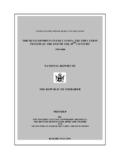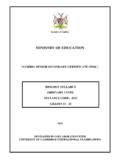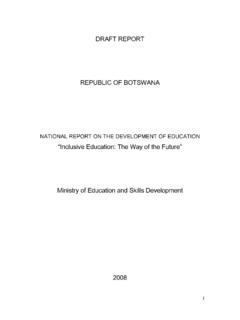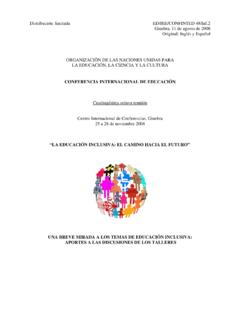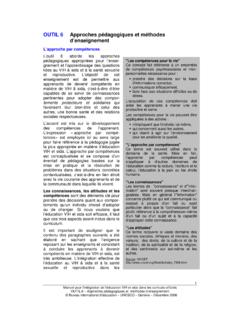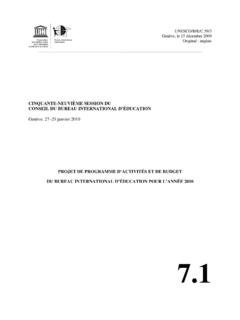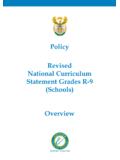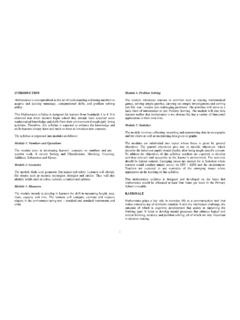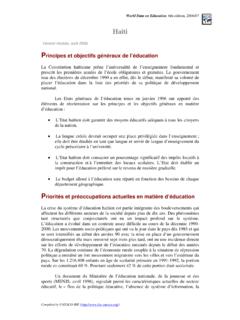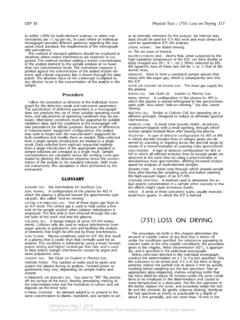Transcription of How children learn - International Bureau of Education
1 International ACADEMYOF EDUCATIONINTERNATIONAL BUREAUOF EDUCATIONH owchildrenlearnBy Stella VosniadouEDUCATIONAL PRACTICES SERIES 7 The International Academyof EducationThe International Academy of Education (IAE) is a not-for-profit scientific association that promotes educationalresearch, its dissemination, and the implementation of itsimplications. Founded in 1986, the Academy is dedicated tostrengthening the contributions of research, solving criticaleducational problems throughout the world, and providingbetter communication among policy makers, researchers andpractitioners. The seat of the Academy is at the RoyalAcademy of Science, Literature and Arts in Brussels, Belgium,and its co-ordinating centre is at Curtin University ofTechnology in Perth, general aim of the IAE is to foster scholarly excel-lence in all fields of Education .
2 Towards this end, theAcademy provides timely syntheses of research-basedevidence of International importance. The Academy alsoprovides critiques of research, its evidentiary basis, and itsapplication to current members of the Board of Directors of theAcademy are: Erik De Corte, University of Leuven, Belgium (President) Herbert Walberg, University of Illinois at Chicago, UnitedStates of America (Vice President) Barry Fraser, Curtin University of Technology, Australia(Executive Director) Jacques Hallak, Paris, France Michael Kirst, Stanford University, United States ofAmerica Ulrich Teichler, University of Kassel, Germany Margaret Wang, Temple University, United States booklet is about how children learn . It has been preparedfor inclusion in the Educational Practices Series developed bythe International Academy of Education and distributed by theInternational Bureau of Education and the Academy.
3 As part ofits mission, the Academy provides timely syntheses of researchon educational topics of International importance. This book-let is the seventh in the series on educational practices thatgenerally improve author is Stella Vosniadou, who has written many arti-cles and books in the area of cognitive, developmental andeducational psychology. She has taught at the University ofIllinois in Urbana-Champaign and at the University of Athens,and was president of the European Association for Research onLearning and Instruction. She is currently the director of a grad-uate programme in cognitive science in the Department ofPhilosophy and History of Science at the University of officers of the International Academy of Education areaware that this booklet is based on research carried out prima-rily in economically advanced countries.
4 The booklet, however,focuses on aspects of how children learn that appear to beuniversal in much formal and informal schooling. The practicespresented here are likely to be generally applicable through-out the world. Even so, the principles should be assessed withreference to local conditions, and adapted accordingly. In anyeducational setting or cultural context, suggestions or guide-lines for practice require sensitive and sensible application, andcontinuing J. WALBERGE ditor, IAE Educational Practices SeriesUniversity of Illinois at Chicago3 Previous titles in the Educational practices series 1. Teaching by Jere Brophy. 36 Parents and learningby Sam Redding. 36 Effective educational practicesby Herbert J. Walberg andSusan J. Paik. 24 Improving student achievement in mathematicsby DouglasA.
5 Grouws and Kristin J. Cebulla. 48 Tutoring by Keith Topping. 36 Teaching additional languages by Elliot L. Judd, Lihua Tanand Herbert J. Walberg. 28 titles can be downloaded from the websites of the IEA( ) or of the IBE( ) or paper copies canbe requested from: IBE, Publications Unit, Box 199, 1211 Geneva 20, of contentsIntroduction, page 61. Active involvement, page 82. Social participation, page 93. Meaningful activities, page 114. Relating new information to prior knowledge, page 125. Being strategic, page 146. Engaging in self-regulation and being reflective, page 167. Restructuring prior knowledge, page 188. Aiming towards understanding rather than memorization,page 209. Helping students learn to transfer, page 2210. Taking time to practice, page 2311.
6 Developmental and individual differences, page 2512. Creating motivated learners, page 27 References and further reading, page 295 This publication has been produced in 2001 by the InternationalAcademy of Education (IAE), Palais des Acad mies, 1, rue Ducale,1000 Brussels, Belgium, and the International Bureau of Education (IBE), Box 199, 1211 Geneva 20, Switzerland. It is availablefree of charge and may be freely reproduced and translated into otherlanguages. Please send a copy of any publication that reproducesthis text in whole or in part to the IAE and the IBE. This publicationis also available on the Internet. See the Publications section, Educational Practices Series page at: author is responsible for the choice and presentation of the factscontained in this publication and for the opinions expressed therein,which are not necessarily those of UNESCO/IBE and do not committhe organization.
7 The designations employed and the presentationof the material in this publication do not imply the expression of anyopinion whatsoever on the part of UNESCO/IBE concerning the legalstatus of any country, territory, city or area, or of its authorities, orconcerning the delimitation of its frontiers or in France by SADAG, psychological principles described in this booklet summarizesome of the important results of recent research on learningthat is relevant for Education . They attempt to integrate researchcoming from diverse areas of psychology, including educational,developmental, cognitive, social and clinical psychology. Thisresearch has offered us new insights into the learning processand the development of knowledge in many subject-matterareas. As a result, curricula and instruction are changing inschools today.
8 They are attempting to become more student-centred than teacher-centred, to connect the school to real-lifesituations, and to focus on understanding and thinking ratherthan on memorization, drill and each principle is explained on its own, all twelveprinciples are best understood as an organized whole withone supporting the others. As a whole, these principles aremeant to provide a comprehensive framework for the designof curricula and of instruction. Indeed, they are found behinda number of innovative programmes in schools across theworld begin with a discussion of three principles that arewidely recognized as forming the basis on which teachersshould design the learning environments of today s schools;namely, learning environments that encourage students to beactive learners, to collaborate with other students, and to usemeaningful tasks and authentic materials.
9 We continue withseven principles that focus on cognitive factors that are primarilyinternal, but also interact with environmental factors inimportant ways. Teachers need to take these principles intoconsideration in order to design more effective curricula andinstruction. We end with a discussion of developmental andindividual differences, and with motivational influences onlearning. These last two areas are very important for learningand instruction, and to be treated adequately deserve tobecome independent have not dealt with a subject that is becoming veryimportant in the schools of today the use of information andcommunication technology to support learning. We have notdone so because this area is too vast and we believe that aspecial booklet needs to be devoted to discussing each principle, we start by presenting asummary of the research findings and then continue describingthe implications for teaching that follow from them.
10 At the endof the booklet there is a list of references and suggested readingsthat provide further information on the principles that havebeen discussed. involvementLearning requires the active, constructiveinvolvement of the findingsLearning at school requires students to pay attention, to observe,to memorize, to understand, to set goals and to assume respon-sibility for their own learning. These cognitive activities are notpossible without the active involvement and engagement of thelearner. Teachers must help students to become active and goal-oriented by building on their natural desire to explore, to under-stand new things and to master the classroomIt is a challenge for teachers to create interesting and challenginglearning environments that encourage the active involvementof students.
